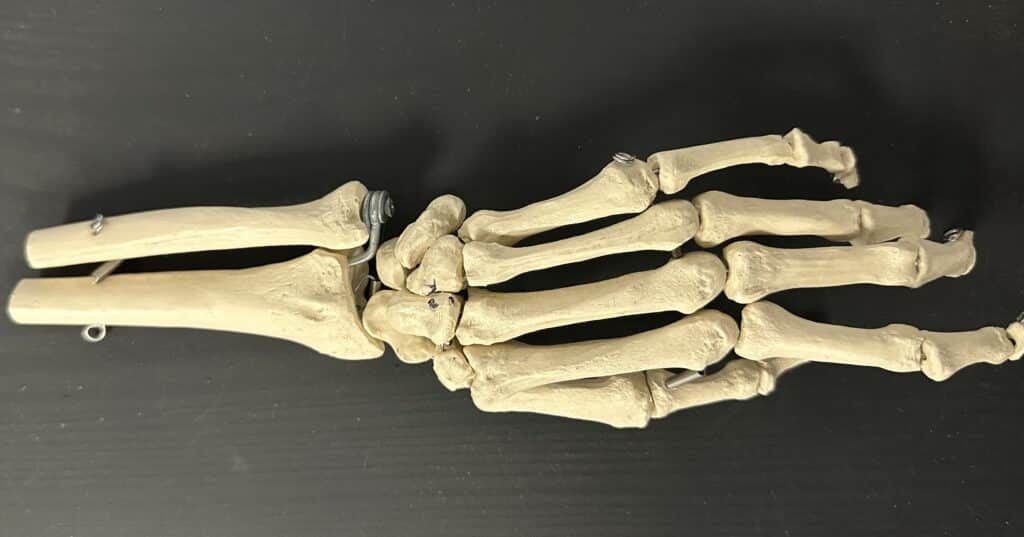CMC joint arthritis, also known as base of thumb arthritis, affects the base of the thumb, causing pain and limiting movement. This condition can make everyday tasks difficult. In this article, we’ll look at the symptoms, causes, treatments, and ways to prevent CMC joint arthritis.
Key Takeaways
CMC joint arthritis primarily affects the basal joint of the thumb, leading to pain, stiffness, and reduced functionality, especially in individuals over 60 years old.
Diagnosis involves a detailed medical history, physical examination, and imaging techniques, such as X-rays, MRI scan or CT to assess cartilage deterioration and severity of the condition.
Non-surgical treatments, including bracing, exercise, and pain relief injections, are effective for early-stage management, while surgical interventions such as joint replacement may be necessary for severe cases.
Understanding CMC Joint Arthritis
Carpometacarpal (CMC) joint arthritis, is the most common form of arthritis affecting the thumb carpometacarpal . This condition primarily involves the thumb basal joint, where the metacarpal bone of the thumb meets the wrist.
Osteoarthritis (OA), the most prevalent type of arthritis, frequently targets this joint, leading to pain, stiffness, and loss of normal thumb function. Additionally, thumb basal joint arthritis can significantly impact daily activities.
Several factors contribute to the development of CMC joint arthritis:
Aging, which leads to worn cartilage and joint wear, resulting in osteoarthritis
Certain hereditary conditions
Prior joint injuries
Overuse of the thumb
Statistics show that individuals over 40 years old, particularly women, are at a higher risk of developing CMC joint arthritis.
The symptoms of thumb arthritis are not just limited to pain and stiffness.
Common symptoms include:
Muscle weakness
Noticeable bone spurs
Joint deformity
Swelling
Decreased thumb mobility, especially after periods of inactivity
Recognizing these symptoms and risk factors aids in early detection and effective management of thumb CMC arthritis.
Symptoms of Thumb CMC Arthritis
The main symptom of thumb CMC arthritis is pain at the base of the thumb. This pain can present as a sharp or aching sensation, often worsening during movement and easing with rest. Activities such as gripping or picking up objects can become particularly challenging, as the pain intensifies during these actions.
Swelling around the base of the thumb is another common symptom, indicating inflammation within the joint. As the arthritis progresses, individuals may notice that their thumb has limited motion, making it difficult to perform everyday tasks. The thumb joint may feel stiff, especially in the morning or after periods of inactivity, impacting the overall functionality of the hand.
These symptoms not only cause physical discomfort but also affect one’s quality of life. Simple tasks such as opening a jar or typing on a keyboard, become painful.
Early recognition and medical advice can manage the condition more effectively and prevent further deterioration of the thumb joint.
Diagnosing Thumb CMC Arthritis
Diagnosing thumb arthritis requires reviewing the patient’s medical history and conducting a detailed physical examination. During the examination, doctors check for pain or a grinding sound in the thumb joint, which are key indicators of arthritis.
Imaging techniques, particularly X-rays and MRI scan (and more recently ultrasound scan), are vital in confirming thumb arthritis. X-rays can reveal the extent of cartilage deterioration and the presence of bone spurs, which are common in advanced stages of arthritis. These images offer a clear view of the joint and help assess the severity of the condition.
Risk factors such as being female, over 40 years old, also contribute to the development of thumb arthritis. Early identification of these risk factors can aid in timely diagnosis and intervention, potentially slowing disease progression. A thorough diagnosis helps devise an effective treatment plan tailored to the patient’s specific needs.
Non-Surgical Treatments for CMC Joint Arthritis
The initial approach for many involves managing thumb CMC arthritis with non-surgical treatments. Methods like bracing, anti-inflammatory medications, activity modification, and icing the joint can be highly effective, especially in early stages.
While surgery remains an option for severe cases, surgical intervention often provides significant relief and helps maintain thumb functionality.
Exercise and Physical Therapy
Exercise and physical therapy are pivotal in managing CMC joint arthritis. Specific exercises enhance thumb strength and stability, reducing pain and improving function. Dynamic stabilization exercises, for instance, focus on the supportive muscles around the thumb joint, helping to alleviate pain.
Simple yet effective exercises include using a tennis ball and an elastic band to move the index finger sideways, or making a loose fist with an elastic band around the fingers and sliding the thumb away for resistance. These exercises, when performed regularly, can significantly improve thumb mobility and strength. Performing these exercises every 1-2 hours is often recommended for optimal results.
Warming the hand with a heat pack or soaking it in warm water for up to five minutes before exercising can be beneficial. This helps prepare the muscles and joints for the activity, reducing the risk of strain. If exercises cause discomfort, checking technique and reducing repetitions can help avoid exacerbating the condition.
Joint Protection Techniques
Joint protection techniques are crucial for managing thumb CMC arthritis and preventing further damage. Recognizing thumb pain during activities is key, as it warns that the activity may be causing joint damage. By paying attention to pain patterns, individuals can adjust their activities to minimize stress on the thumb joint.
Effective techniques include using larger joints for tasks instead of relying solely on the thumb. For instance, hugging large objects close to the body or using both hands to lift items can distribute the load and reduce strain on the thumb joint. Such simple adjustments can significantly maintain thumb health and functionality.
Pain Relief Options
Pain relief is crucial in managing thumb CMC arthritis. Corticosteroid injections effectively reduce inflammation and pain in the thumb joint. These injections provide temporary relief, often lasting several months, making them viable for severe symptoms.
Steroid injections cannot be used indefinitely, as their effectiveness diminishes over time. The decision to use these injections is made based on individual symptoms and the severity of the condition.
Besides injections, anti-inflammatory medications and icing the joint offer temporary relief and help manage pain.
Splints and Bracing
Splints and braces support the thumb CMC joint, reduce pain, and prevent further damage. These devices can be made from soft materials like neoprene or thermoplastic, and custom orthoses designed by hand therapists meet individual needs. Wearing splints provides necessary support and protection for individuals with thumb arthritis.
Splints should be worn during painful activities and at night if experiencing pain. For constant pain, wearing a splint nearly full time may be advised to provide ongoing support. Contact the Hand Therapy Team for advice and adjustments if there are concerns about the splint.
Wearing a splint may take over six weeks to show noticeable pain reduction. After surgery, wearing a cast or splint for about six weeks is common to ensure proper healing. This long-term use helps maintain thumb stability and reduces the risk of further injury.
Surgical Interventions for Severe Cases
When non-surgical treatments fail, surgical interventions become necessary for managing thumb CMC arthritis. Surgery is considered when symptoms cannot be managed with other methods. Your consultant will discuss the various surgical options available.
Types of Surgery
Several surgical procedures treat thumb CMC arthritis. The most common surgery involves:
Removing the arthritic bone, alleviating pain and restoring function
Joint replacement, substituting the affected joint with a tendon graft
Osteotomy, which can correct joint deformities by repositioning the bones
The choice of surgery depends on the individual’s condition and the arthritis severity. Each surgical option aims to reduce pain and improve thumb functionality, offering a long-term solution for severe thumb CMC arthritis.
Recovery Process
Recovery after thumb arthritis surgery can take up to one year, with a timeline ranging from two months to a year for complete recovery. Patients may need to wear a cast or splint for 4 to 8 weeks after surgery to ensure proper healing. Physical therapy is recommended for rehabilitation, aiding in regaining strength and movement in the thumb.
Discomfort is common in the initial stages of rehabilitation, but many patients report satisfaction with their outcomes after treatment. Full recovery typically takes several months, and significant pain reduction from wearing a splint may take over six weeks.
Preventing Thumb CMC Arthritis
Preventing thumb CMC arthritis involves using ergonomic tools and adjusting daily tasks to reduce strain on the thumb joint. Practicing joint protection techniques, like distributing loads across multiple joints instead of relying solely on the thumb, can significantly lower the risk of developing osteoarthritis.
Targeted exercises that strengthen the muscles around the thumb joint enhance stability and flexibility, aiding in prevention. Regular breaks from repetitive tasks allow the thumb joint to rest, preventing overuse injuries.
Living with CMC Joint Arthritis
Living with CMC joint arthritis necessitates adjustments to daily activities to manage symptoms and maintain independence. Assistive devices ease daily tasks by minimizing pain and enhancing independence. Lever arm devices reduce the effort needed for tasks, and large-grip tools lessen strain on smaller joints during various activities.
Occupational therapists can advise on the use of assistive devices, helping individuals with thumb arthritis maintain their quality of life. Modifying activities, like using both hands for tasks, helps manage symptoms and reduce stress on the thumb joint.
Summary
Managing CMC joint arthritis involves a combination of understanding the condition, recognizing symptoms, exploring non-surgical and surgical treatments, and implementing preventive measures. By taking proactive steps and making necessary adjustments, individuals with thumb arthritis can maintain their quality of life and manage their symptoms effectively. Remember, early intervention and consistent management are key to living well with thumb CMC arthritis.
Frequently Asked Questions
What are the common symptoms of thumb CMC arthritis?
The common symptoms of thumb CMC arthritis include pain at the base of the thumb, stiffness, swelling, and difficulty gripping or picking up objects. It is important to recognize these symptoms for timely intervention.
How is thumb CMC arthritis diagnosed?
Thumb CMC arthritis is diagnosed through a comprehensive review of the medical history, a physical examination, and imaging techniques such as X-rays to confirm the arthritis.
What non-surgical treatments are available for thumb CMC arthritis?
Non-surgical treatments for thumb CMC arthritis primarily involve bracing, anti-inflammatory medications, activity modification, icing the joint, and physical therapy. These approaches can effectively reduce pain and improve function.
When is surgery considered for thumb CMC arthritis?
Surgery for thumb CMC arthritis is considered when non-surgical treatments fail to alleviate symptoms, making the condition unmanageable.
How long does recovery take after thumb arthritis surgery?
Recovery after thumb arthritis surgery can take approximately two months to a year, with full recovery often reaching up to one year. Engaging in physical therapy is advisable for optimal rehabilitation.






